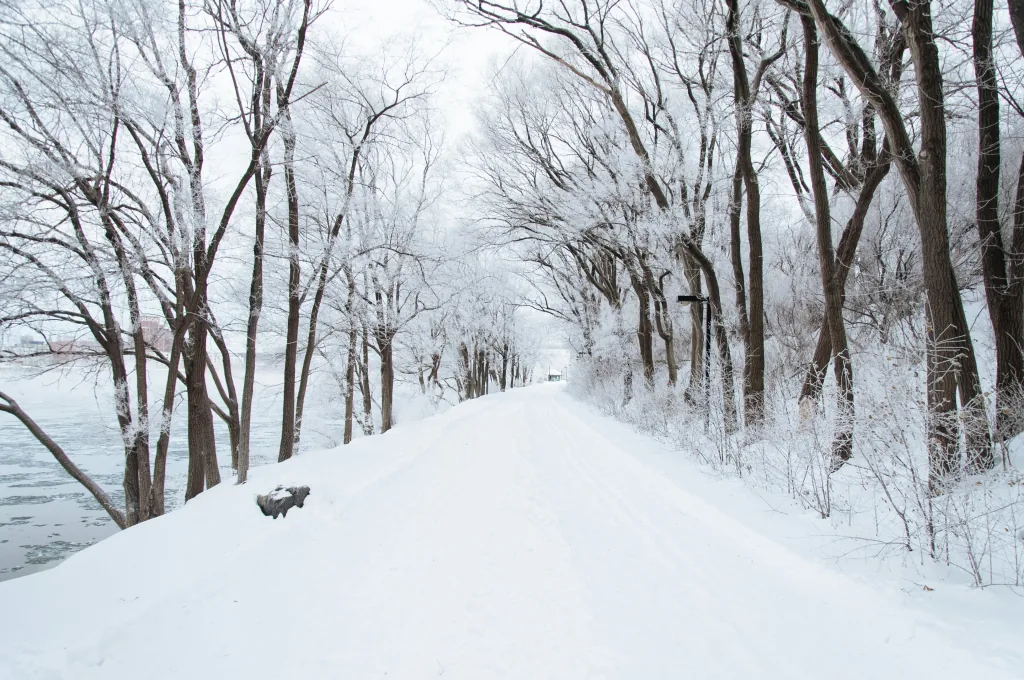Winter Storm Blair is here, and with it comes a whole new set of safety challenges for those working outdoors. Frigid temperatures, biting winds, and icy conditions can quickly turn dangerous if you’re not prepared. At Cascade QMS, we’re committed to helping contractors like you stay safe and productive, no matter the weather.
Why Cold Weather Safety Should Be Top of Mind
Working in cold environments can lead to serious health issues like:
- Hypothermia: This potentially life-threatening condition occurs when your body loses heat faster than it can produce it, causing a dangerous drop in core body temperature. Early signs include intense shivering, slurred speech, confusion, and fatigue.
- Frostbite: Freezing of skin and underlying tissues, most commonly affecting extremities like fingers, toes, ears, and nose. Frostbite can cause permanent damage and, in severe cases, may even lead to amputation. Watch for numbness, tingling, or a waxy appearance of the skin.
- Trench Foot: Also known as immersion foot, this condition develops from prolonged exposure of the feet to cold and wet conditions. Symptoms include tingling, itching, numbness, and blisters.
Beyond these specific illnesses, cold weather can also significantly increase the risk of workplace accidents. Cold temperatures can impair dexterity, reduce reaction times, and affect judgment, making workers more prone to slips, trips, and falls. Icy surfaces, reduced visibility, and bulky clothing can further exacerbate these risks.
Why Your Business Needs a Strong Cold Weather Safety Program
Did you know that a strong cold weather safety program can actually improve your company’s standing with clients? Platforms like ISNetworld and Veriforce, used by many major corporations to prequalify contractors, heavily weigh safety records and programs. Having a robust cold weather/cold stress program in place not only protects your workers but also demonstrates your commitment to safety and can significantly impact your company’s grade and competitiveness.
Key Cold Weather Safety Practices
Here are some essential tips to keep your team safe this winter:
- Proper PPE: Layering is the foundation of effective cold weather protection. Encourage workers to wear:
- Moisture-wicking base layers: These wick sweat away from the skin, keeping workers dry and warm.
- Insulating mid-layers: Fleece, wool, or synthetic materials trap warm air and provide insulation even when wet.
- Wind and waterproof outer layers: A durable shell protects against wind, rain, and snow.
- Essential accessories: Don’t forget insulated gloves, hats that cover the ears, and sturdy, waterproof footwear with good traction.
- Recognize the Signs: Train your team to identify the early symptoms of cold-related illnesses. Shivering, confusion, slurred speech, and numbness are all red flags.
- Warm-Up Breaks: Regular breaks in a warm, dry area are crucial. Encourage workers to hydrate with warm beverages (avoiding caffeine and alcohol) and eat high-calorie snacks to maintain energy levels.
- Buddy Up: Implement a buddy system so workers can keep an eye on each other and provide assistance if needed.
- Maintain a Safe Worksite: Clear snow and ice from walkways and work areas. Provide salt or sand for traction. Be mindful of icicles and other potential hazards.
Example #1: Winter Safety for Pipeline Contractors
Contractor: ABC Pipeline Services
Application: Performing maintenance and repair work on natural gas pipelines in Southern California during the winter months (November – February).
Why they need a cold weather/cold stress program:
- Unexpected temperature drops: While Southern California is known for its mild climate, temperatures can drop significantly, especially overnight and in inland areas. This can create unexpected hazards for workers who may not be accustomed to colder conditions.
- Coastal winds: Strong winds along the coast can exacerbate cold temperatures and create wind chill, increasing the risk of hypothermia for workers exposed to the elements.
- Rain and potential for flooding: Southern California’s rainy season coincides with the winter months. Heavy rainfall can lead to flooding, creating hazardous conditions for pipeline workers, particularly in low-lying areas or near waterways.
- Hazardous materials: Working with natural gas always presents risks. Cold temperatures can affect the integrity of equipment and materials, potentially increasing the risk of leaks, fires, and explosions.
- Specialized equipment: Maintaining pipelines involves using heavy machinery, welding equipment, and other specialized tools. Rain and wet conditions can create electrical hazards and make it more challenging to operate equipment safely.
- Confined spaces: Pipeline work often involves entering confined spaces, such as trenches or valve boxes. Cold temperatures, rain, and potential flooding can make these spaces even more hazardous.
Specific elements of a cold weather/cold stress program for ABC Pipeline Services:
- Awareness and preparedness: Train workers on the potential hazards of cold weather in Southern California, including recognizing the signs and symptoms of cold-related illnesses and understanding the risks associated with rain and wind.
- Layered clothing: Encourage workers to dress in layers, including moisture-wicking base layers, insulating mid-layers, and waterproof outer layers, to adapt to changing weather conditions.
- Rain gear: Provide workers with waterproof jackets, pants, and footwear to protect them from rain and potential flooding.
- Safe equipment operation: Train workers on the safe operation of equipment in wet and cold conditions, including proper grounding techniques and electrical safety procedures.
- Confined space safety: Reinforce confined space entry procedures, emphasizing the additional hazards posed by cold weather and potential flooding. Ensure proper ventilation and atmospheric monitoring.
- Emergency response: Develop and practice emergency response plans for various scenarios, including cold-related illnesses, equipment malfunctions, and natural gas leaks.
- Communication: Maintain clear communication channels to keep workers informed about weather conditions, potential hazards, and any changes to work schedules or procedures.
By implementing a cold weather/cold stress program tailored to the specific conditions of Southern California, ABC Pipeline Services can protect its workforce from the unexpected challenges of winter, minimize risks associated with working with natural gas, and ensure the safe and efficient operation of critical energy infrastructure.
Example #2: Winter Safety for Lumber Suppliers
Supplier: XYZ Lumber & Building Materials
Application: Delivering lumber and other building supplies to residential and commercial construction sites across Washington state during December through February.
Why they need a cold weather/cold stress program:
- Diverse climate: Washington state experiences a wide range of winter conditions, from mild, rainy weather in coastal areas to heavy snowfall and freezing temperatures in the mountains and eastern regions. This variability poses challenges for drivers and outdoor workers.
- Mountain passes: Deliveries often involve traversing mountain passes, which can be treacherous in winter due to snow, ice, and strong winds. Drivers need to be prepared for these conditions and equipped with the skills and knowledge to navigate them safely.
- Outdoor work: Employees loading, unloading, and securing building materials at the lumber yard and delivery sites are exposed to the elements, increasing the risk of cold-related illnesses and injuries.
- Material handling: Lifting and moving heavy lumber and building supplies in cold temperatures can be physically demanding and increase the risk of strains, sprains, and back injuries.
- Driving hazards: Delivery drivers face increased risks on the road due to potential black ice, reduced visibility, and challenging winter driving conditions.
Specific elements of a cold weather/cold stress program for XYZ Lumber & Building Materials:
- Driver safety: Provide comprehensive training on safe driving practices in winter conditions, including:
- Vehicle inspections: Checking tire pressure, fluids, brakes, and lights before each trip.
- Chain installation: Knowing how to install and use tire chains when required.
- Mountain driving techniques: Maintaining safe speeds, increasing following distances, and navigating curves and steep grades.
- Emergency preparedness: Carrying winter survival kits with blankets, extra clothing, food, water, and emergency communication devices.
- Proper lifting techniques: Reinforce proper lifting techniques and encourage the use of mechanical aids, like forklifts and dollies, to reduce the risk of musculoskeletal injuries when handling heavy materials in cold temperatures.
- Appropriate PPE: Ensure workers have access to and wear appropriate cold weather gear, including insulated jackets, waterproof and windproof outerwear, gloves, and hats, as needed.
- Slips, trips, and falls prevention: Maintain clear and safe pathways at the lumber yard and delivery sites, and provide salt or sand for traction on icy surfaces. Encourage workers to wear sturdy footwear with good traction.
- Warm-up areas: Provide designated warm-up areas, such as heated break rooms or trailers, where employees can take breaks from the cold and warm up regularly.
- Hydration: Encourage workers to stay hydrated, even in colder weather, as dehydration can contribute to cold-related illnesses and fatigue.
- Communication and awareness: Keep employees informed about current and forecasted weather conditions, road closures, and any other potential hazards.
By implementing a robust winter safety program, XYZ Lumber & Building Materials can protect its employees from the unique challenges of Washington’s winter weather, reduce the risk of accidents and injuries, and maintain efficient operations throughout the season.
Cascade QMS Can Help
We offer comprehensive cold weather/cold stress safety programs, including:
- Written Safety Programs: Detailed, site-specific programs that meet ISNetworld and Veriforce requirements.
- Toolbox Talks: Engaging training sessions to reinforce key safety concepts. Contact us today for a free Toolbox Talk on winter safety!
- Onsite Training and Consultation: Expert guidance to help you develop and implement effective cold weather safety protocols.
Don’t let the cold weather put your team at risk. Contact Cascade QMS today for more winter safety tips and to let us help you create a safe and productive work environment this winter.

